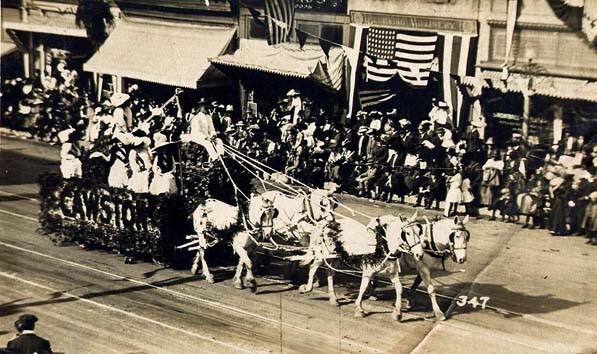Happy New Year! How the Holiday Took Aim at Easterners

The Cawston Ostrich Farm, sponsor of this crowded float, was one of several Los Angeles-area tourist destinations at the turn of the century. The farm sold feathers for the elaborate hats and fans of the era and offered ostrich rides for the daring.
Chariot races -- using a four-horse team -- were a a regular feature of the Tournament of Roses at the turn of the century. Slightly less dangerous football replaced the chariots and horses.
The score that day in 1924 was Washington-14, Navy-14.
A publicity photo, uncredited and uncaptioned, but illustrating a perennial winter theme in the selling of Los Angeles: swimming in January.
According to the Herald-Examiner's caption: "New Year celebration at the Hollywood Canteen. Shown are Tarawa veteran Seaman First Class Clayton Johnson, Dolores Moran, and Cpl. 'Bing' Crosby wishing everyone a Victory New Year for 1944."
Originally captioned, with some unintended irony: "All lit up to ring in the new year. L.A.'s City Hall brightens up Civic Center. (Note citizen trying to catch 40 winks before midnight.)"
The Examiner captioned this "New Year's revelers make merry as the New Year arrives in the Terrace Room at the Statler Hotel, which was sold out. Standing are Miss Dana Sirdenis and Jimmy McEwan; seated are Miss Carolee Fithian and D.S. Fischer."
The Examiner enthused: "All Year Swimming Club members annual New Year's Day swim at Santa Monica beach: Jean Goddard, Marilyn Schliff, Pat Wibe, Margie Kiefer, Terri Varley, Ruth Hachenberger, and Peggy Stracke. The girls are all members of Janet Dee's Santa Monica Surfboard Ballet."
And may 2013 be a year of all good things for you! DJW


